Cells as Basic Units of Life
After decades of studies, cells are now regarded as the basic units of life. A living thing, whether made of one cell (like bacteria) or many cells (like human), is called an organism. And cells are the building blocks of all organisms.
Human Body
Human body is composed of living cells and extracellular materials, and organised into tissues, organs, and organ systems. 60% of a human body is made up of water, and every second the body produces about 25 million new cells.
Kingdom of Living Things
Millions of living things are inhabiting Earth, and in order to systematically study every organism, science classifies living things into six kingdoms according to their ancestry over the course of evolution. This means that all the species that make up these six kingdoms have common ancestors, and therefore share some of their genes and belong to the same family tree.
Space Science
Space Science is the body of scientific knowledge as it relates to space exploration. Space science draws on the conventional sciences of physics, chemistry, biology, and engineering, as well as requiring specific research of its own.
Art
Art is a diverse range of human activities engaged in creating visual, auditory, or performed artefacts that express the artist’s imaginative or technical skill, and are intended to be appreciated for their beauty or emotional power. Some scholars claimed that the greatest innovation in the history of humankind was neither the stone tool nor the steel sword, but the invention of symbolic expression (artworks) by the first artists.
Cultural Heritage & History
Cultural heritage brings to mind artefacts, historical monuments and buildings, as well as archaeological sites. However, cultural heritage is not only limited to material objects that we can see and touch. It also consists of immaterial elements: traditions, oral history, performing arts, social practices, traditional craftsmanship, representations, rituals, knowledge and skills transmitted from generation to generation within a community. Thus, cultural heritage can be tangible, intangible, or a mixture of both.
Archeology
Archaeology is the study of humanity and its past using material remains that were left behind. These remains can be any objects that people created, modified, or used in the past, such as lithic tools, a simple hut dwelling, a skeleton covered with gold jewellery or a pyramid that majestically rises from a desert floor.Featured


Organ Systems
All matter in the universe are made of atoms. Atoms combine to become compounds and molecules, and together they form cell's organelles. Cells are the basic units of structures and specific functions in the human body. A tissue is a group of connected cells that have similar function; two or more types of tissues form an organ. Human organs are organised into 11 organ systems. An organ system is a group of organs that work together to carry our complex overall function with the ultimate goal of maintaining homeostasis (the stable state of internal, physical, and chemical conditions of the body).Cells as Basic Units of Life

Plant cell
Plant cells are the basic unit of life in organisms of the Kingdom Plantae. They are eukaryotic cells, meaning they have a true nucleus along with specialised structures (organelles) that carry out different functionsSee more >

Animal Cell
Animal cells are the basic unit of life in organisms of the kingdom Animalia. They are eukaryotic cells, meaning that they have a true nucleus and specialised structures called organelles that carry out different functions. Animal cells do not have plant-specific organelles like cell walls, which support the plant cell, or chloroplasts, the organelle that carries out photosynthesis.See more >
Organ Systems

cardiovascular system
The cardiovascular system is sometimes called the circulatory system. It consists of the heart, which is a muscular pumping device, and a closed system of vessels called arteries, veins, and capillaries. As the name implies, blood contained in the circulatory system is pumped by the heart around a closed circle or circuit of vessels as it passes again and again through the various circulations of the body.See more >

Lymphatic System
The lymphatic system is a network of tissues and organs that help rid the body of toxins, waste and other unwanted materials. The primary function of the lymphatic system is to transport lymph, a fluid containing infection-fighting white blood cells, throughout the body. It consists of a network of lymph vessels and ducts that collect excess fluid (lymph) from extracellular spaces in tissues and transport the fluid to the bloodstream.See more >

Digestive System
The digestive system consists of the mouth, oesophagus, stomach, and the small and large intestines that form a long tube called the gastrointestinal (GI) tract. Food moves through this tract where it is digested, its nutrients absorbed, and its waste products excreted. The six major activities of the digestive system are ingestion, propulsion, mechanical breakdown, chemical digestion, absorption, and elimination.See more >

Muscular System
The muscular system consists of three different types of muscles: skeletal muscles, smooth muscles, and cardiac muscles. The skeletal muscles are attached to bones by tendons; they allow for voluntary movements of the body. While smooth muscles control the involuntary movements of most internal organs, the cardiac muscles control the involuntary beating of the heart, allowing it to pump blood through the blood vessels of the cardiovascular system.See more >

Skeletal System
The skeletal system consists of bones, joints, and teeth. The bones of the skeletal system are connected by tendons, ligaments, and cartilage. Functions of the skeletal system include supporting the body and giving it shape. Along with the muscular system, the skeletal system enables the body to move. The bones of the skeletal system also protect internal organs, store calcium, and produce red and white blood cells.See more >

Respiratory System
The respiratory system is the network of organs and tissues that help you breathe. It includes your airways, lungs, and blood vessels. The muscles that power your lungs are also part of the respiratory system. These parts work together to move oxygen throughout the body and clean out waste gases like carbon dioxide.See more >
Featured

Kingdom of Animalia
All animals (including humans) belong to a biological kingdom of Animalia, which can be further broken down into two types: animals with backbones (vertebrates) and animal without backbones (invertebrates). While invertebrates is a class on its own, vertebrates are further broken down into five classes: Mammals, Reptiles, Amphibians, Birds, and Fish.
Kingdom of Plantae
The Kingdom of Plantae contains all plants on planet Earth. Plants are multicellular organisms with special, rigid cell wall enveloping their cell membranes. For most plants, photosynthesis is their principle mode of nutrition, and this makes them autotrophs.
Mammals
A mammal is any member of the group of vertebrate animals in which the young are nourished with milk from special mammary glands of the mother. Mammals can further be divided into three subclasses: Monotremes mammals, marsupial mammals, and placental mammals.
Reptiles
Reptiles are cold-blooded vertebrates (animals with backbones), and they rely on heat from their surroundings to warm-up. They generally have dry skin, covered either with scales or horny plates. They breathe using lungs, and most species eat other animals, and lay eggs on land to breed.Kingdom of Animalia

Echidna
Echidnas, the only living mammals that lay eggs, belong to the family Tachyglossidae. They are usually between 12 and 17 inches long and weigh between 4 and 10 pounds. They have spines like a porcupine, a beak like a bird, and a pouch like a kangaroo. Echidnas evolved between 20 and 50 million years ago, descending from an aquatic, platypus-like monotreme. Despite their aquatic origin, echidnas have adapted to life on land.See more >

Kangaroo
The kangaroo is a marsupial from the family Macropodidae (macropods, meaning "large foot"). In common use, the term describes the largest species from the family. They are indigenous to Australia and New Guinea.See more >

Blue Whale
The blue whale (Balaenoptera musculus) is a marine mammal belonging to the baleen whale suborder Mysticeti. Reaching a maximum confirmed length of about 100 feet, and weighing up to 200 tonnes, it is the largest animal known to have existed.See more >

Green Sea Turtle
The green sea turtle is the only herbivore among the different sea turtle species. There are two types of green turtles: the Atlantic green turtle, which is normally found off the shores of Europe and North America; and the Eastern Pacific green turtle, which has been found in coastal waters from Alaska to Chile. Today, scientists are still debating whether these two are subspecies or separate species.See more >

common house gecko
The common house gecko (Hemidactylus frenatus), is a gecko native to South and Southeast Asia and is also known as the Asian house gecko, Pacific house gecko, wall gecko, house lizard, or moon lizard. Common house geckos are carnivores (insectivores). Their diet is made up of cockroaches, termites, some bee and wasps, butterflies, moths, flies, spiders, and several beetle groupings.See more >

Panamanian golden frog
The Panamanian golden frog, also known as Cerro Campana stubfoot toad and other names, is a species of toad endemic to Panama. The golden frogs inhabit the streams along the mountainous slopes of the Cordilleran cloud forests of west-central Panama. The IUCN lists the Panamanian Golden frog as critically endangered. The frog has been collected for breeding in captivity in a bid to preserve the species.See more >

Axolotl
The Axolotl, also referred as Mexican Walking Fish, is considered to be one of the world’s most unique species of salamanders. It measures between 15-45 centimetres in length and weigh about 0.06 to 0.1 kilogram, but can reach 0.5 kilograms in captivity. Although colloquially known as a "walking fish", the axolotl is not a fish but an amphibian.See more >

Crowned Woodnymph
Lorem ipsum dolor sit amet consectetur adipisicing elit.See more >

Great Horned Owl
The great horned owl is a large and widespread owl with distinctive ear tufts (the "horns"). It can be found in a variety of habitats from dense woods to prairie and deserts with at least some trees, and also in wooded towns and suburbs. Typically it is well-camouflaged dark brown overall, but varies in colour. It often engages in haunting duets, with males and females hooting back and forth. It preys upon a variety of animals, including mammals, birds and reptiles.See more >

Blue Marlin
This Blue-water fish spends most of their lives far out at sea. They feed on mackerel and tuna, but will also dive deep to eat squid. The blue marlins use their spears to slash through dense schools, returning to eat their stunned and wounded victims.See more >

porcupinefish
The porcupinefish belong to the family Diodontidae, and are also commonly called blowfish, balloonfish or globefish. It is a medium size fish that is 25-90 cm long. The fish is called so because it has spines all over its body to protect itself from predators.See more >

emperor scorpion
The emperor scorpion (Pandinus imperator) is one of the largest species of scorpion in the world, with adults averaging about 20 centimetres (7.9 in) in length and a weight of 30 g. Although each scorpion has a venomous stinger on the tip of its tail, adults normally rely on their large claws, or palps, to capture prey.See more >

Blue-ringed octopus
Blue-ringed octopus is one of the highly venomous species of octopus that can be found in tide pools and coral reefs of the Pacific and Indian oceans, from Japan to Australia. They are some of the deadliest marine life in the ocean. They are small in size: no larger than approximately 2.5 inches long, with arms that are about 4 inches long.See more >

bar-tailed godwit
The bar-tailed godwit is a large wader in the family Scolopacidae, which feeds on bristle-worms and shellfish on coastal mudflats and estuaries. It has distinctive red breeding plumage, long legs, and a long upturned bill.See more >
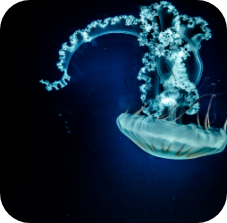
South American sea nettle
Coming soon...
Barracuda
Coming soon...
Rare White Bald Eagle
Coming soon...
Emperor Penguin
Coming soon...
Monarch Butterfly
Coming soon...
Black Widow Spider
Coming soon...
Fire Salamander
Coming soon...
Fringed Leaf Frog
Coming soon...
Tokay Gecko
Coming soon...
Indian Cobra
Coming soon...
Polar bear
Coming soon...
Wombat
Coming soon...
playtypus
Coming soon...Kingdom of Plants

Southern Magnolie Tree
There are around 210 species of magnolia that differ in size, shape, colour of the flower and type of habitat. People plant magnolias in parks and gardens for their visually rich impact and fragrant scent. The southern magnolia has large, white flowers that smell like lemons. They are known partly for their large size, typically growing to a height of up to 80 feet with a spread of up to 40 feet.See more >

Forget me not
Forget-me-not is a herbaceous plant that belongs to the cynoglossum family. There are less than 100 species of forget-me-not, most of which originate from temperate parts of northern hemisphere. While most people cultivate forget-me-not as ornamental purposes, they can be found naturally in moist fields, forests, mountains and along the streams.See more >

Boston Fern
Boston fern, also known as the sword fern, is a species of fern in the family Lomariopsidaceae. This perennial herbaceous plant, is a native to tropical regions in the world and consists of about 30 tropical varieties. Boston fern is a popular variety of ferns for houseplant, as they aren't too picky about anything beyond getting regular watering and some bright, indirect light. Also, it has an ability to grow quickly.See more >

Cedars of Lebanon
Cedars of Lebanon are known throughout ancient art and literature as symbols of power and longevity. They are tall trees with large trunks and massive, irregular heads of spreading branches. Great forests of cedars of Lebanon, were virtually eliminated during early historic times in lumbering operations for such purposes as the construction of King Solomon’s great temple and palace.See more >

Engelmann Spruce
Coming soon...
Broad-leaved tree
Coming soon...
Aloe Vera
Coming soon...
Clamshell Orchid
Coming soon...Featured

Astronomy
Astronomy is the study of the sun, moon, stars, planets, comets, gas, galaxies, gas, dust and other non-Earthly bodies and phenomena.
Astronautics
Astronautics is the theory and practice of travel beyond Earth's atmosphere into outer space. Spaceflight is one of its main applications.
Planetary Science
Planetary science is the scientific study of planets and their planetary systems. It involves understanding how planetary systems are formed; how these systems work; and how all their components interact. Planetary science is a cross-discipline field including aspects of astronomy, atmospheric science, geology, space physics, biology and chemistry.Astronomy

Birth of a Star
The prototype, illustrated in 3D model, of this class of objects is T Tauri, a young star in the Taurus star-forming region. The young accreting star is surrounded by an accretion disk (in blue). The age is less than about ten million years. The model describes the effects of multiple flares occurring in proximity of the accretion disk. The flares lead to the formation of an extended corona composed by hot loops (in red-orange), linking the disk to the protostar.See more >

The Sun
The heart of our solar system is a hot ball of glowing gases yellow dwarf star, the Sun. In understanding the Sun, scientists study how the sun influences the very nature of space. Space is not completely empty. Instead, we live in the extended atmosphere of an active star. The Sun sends out particles and energy (via solar wind) as well as a constantly writhing magnetic system. This extensive, dynamic solar atmosphere surrounds the Sun, the planets, and extends far out into the solar system.See more >

Black Hole
A black hole is a region or a spot in space where gravity pulls so much that even light can not get out. The gravity is so strong because matter has been squeezed into a tiny space. Because no light can get out, people can't see black holes. The theory of general relativity predicts that a sufficiently compact mass can deform spacetime to form a black hole. This can happen when a star is dying.See more >
Astronautics

NASA's Saturn V
The Saturn V was a rocket NASA built to send people to the moon. The V in the name is actually the Roman numeral five. The Saturn V was a type of rocket called a Heavy Lift Vehicle. It was the most powerful rocket that had ever flown successfully. The Saturn V was used in the Apollo program in the 1960s and 1970s. It also was used to launch the Skylab space station.See more >

NASA's Nexus project
The NEXUS reusable rocket was a concept design created in the 1960s by Krafft Ehricke at General Dynamics. It was intended as the next leap beyond the Saturn V, carrying up to eight times more payload. Several versions were designed, including 12,000 and 24,000 short ton vehicles with payloads of one thousand and two thousand short tons respectively. However, it was never built.See more >

LUCY: NASA’s Space Probe
The swarms of Trojan asteroids associated with Jupiter are thought to be remnants of the primordial material that formed the outer planets. These primitive bodies may hold vital clues to deciphering the history of our solar system, and perhaps even the origins of organic material on Earth. Lucy will be the first space mission to study the Trojans. Lucy are planned to launch in October 2023 and, with boosts from Earth's gravity, will complete a 12-year journey to eight different asteroids.See more >

Mercury-Redstone launch vehicle
Coming soon...
Mars lngenuity helicopter
Coming soon...
NASA opportunity rover
Coming soon...
NASA opportunity rover
Coming soon...Planetary science

Earth
Scientists believe that our home planet, Earth, and its moon formed around the same time as the rest of the solar system, which was about 4.5 billion years ago. Earth diameter is about 8,000 miles, which made it to be the fifth-largest planet in the solar system. Our home planet is the third-closest to the sun with an average distance from the sun of about 93 million miles.See more >

Jupiter
Jupiter is the largest planet in the solar system. It is approximately 143,000 kilometers (about 89,000 miles) wide at its equator. Jupiter is so large that all of the other planets in the solar system could fit inside it. More than 1,300 Earths would fit inside Jupiter. Furthermore, the planet's composition is like a star. If Jupiter had been about 80 times more massive, it would have become a star rather than a planet.See more >

Mercury
Mercury is the smallest planet in our solar system and nearest to the Sun; it is only slightly larger than Earth. From the surface of Mercury, the Sun would appear more than three times as large as it does when viewed from Earth, and the sunlight would be as much as seven times brighter. Despite its proximity to the Sun, Mercury is not the hottest planet in our solar system due to its dense atmosphere. Thereby, the hottest planet title belongs to nearby Venus.See more >

Saturn
Saturn is the sixth planet from the Sun and the second largest planet in our solar system. Adorned with thousands of beautiful ringlets, Saturn is unique among the planets. Though it is not the only planet to have rings, but none are as spectacular or as complicated as Saturn's. Like fellow gas giant Jupiter, Saturn is a massive ball made mostly of hydrogen and helium.See more >

Venus
Venus has been called Earth's twin because of its similar size and structure to Earth. However, there are radical differences between the two planets. Venus has a thick, toxic atmosphere filled with carbon dioxide and it is perpetually shrouded in thick, yellowish clouds of mostly sulfuric acid that trap heat, causing a runaway greenhouse effect. This makes Venus the hottest planet in our solar system, even though Mercury is closer to the Sun.See more >

Mars
Mars was named by the ancient Romans for their god of war because its reddish colour was reminiscent of blood. Other civilisations also named the planet for this attribute; for example, the Egyptians called it, Her Desher, meaning, the red one. Even today, it is frequently called the Red Planet because iron minerals in the Martian dirt oxidise, or rust, causing the surface to look red.See more >

Uranus
Uranus is the seventh planet from the Sun with the third largest diameter in our solar system, Uranus is very cold and windy. With a radius of 15,759.2 miles (25,362 kilometers), Uranus is 4 times wider than Earth. If Earth was the size of a nickel, Uranus would be about as big as a softball. This ice giant is surrounded by 13 faint rings and 27 small moons as it rotates at a nearly 90-degree angle from the plane of its orbit. This unique tilt makes Uranus appear to spin on its side, orbiting the Sun like a rolling ball.See more >

Neptune
Dark, cold and whipped by supersonic winds, ice giant Neptune is the eighth and most distant planet in our solar system. More than 30 times as far from the Sun as Earth, Neptune is the only planet in our solar system not visible to the naked eye and the first predicted by mathematics before its discovery. In 2011 Neptune completed its first 165-year orbit since its discovery in 1846.See more >

Pluto (Dwarf planet)
Coming soon...
Ceres (Dwarf planet)
Coming soon...
Makemake(Dwarf planet)
Coming soon...
Huamea (Dwarf planet)
Coming soon...
Eris (Dwarf planet)
Coming soon..Featured

Painting
Painting is the expression of ideas and emotions with the creation of certain aesthetic qualities, in a two-dimensional visual language. The elements of this language — its shapes, lines, colours, tones, and textures — are used in various ways to produce expressive patterns in order to represent real or supernatural phenomena, to interpret a narrative theme, or to create wholly abstract visual relationships.
Sculpture
Sculpture is the branch of the visual arts that operates in three dimensions. Traditionally, durable sculptural processes used carving and modelling in stone, metal, ceramics, wood, and other materials but, since Modernism, there has been an almost complete freedom of materials and techniques.
Music
Music is the art of arranging sounds in time to produce a composition through the elements of melody, harmony, rhythm, and timbre. It is one of the universal cultural aspects of all human societies. The creation, performance, significance, and even the definition of music vary according to culture and social context.Paintings
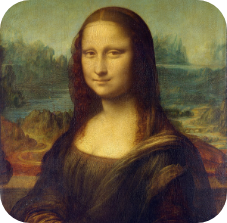
Mona Lisa by Leonardo da Vinci
Mona Lisa, one of the most iconic and recognisable paintings in the world, is a half-length portrait painted by the Italian artist, Leonardo da Vinci. It is thought to be an archetypal masterpiece of the Italian Renaissance. The painting's novel qualities include the subject's enigmatic expression, the monumentality of the composition, the subtle modelling of forms, and the atmospheric illusionism.See more >

Persistence of memory by Dali
The Persistence of Memory was painted in 1931, at the height of the Surrealist Movement. During this time, innovative artists explored ideas of automatism and the self-conscious in their work. This experimental approach to art culminated in a tendency toward peculiar subject matter that evokes dreams and challenges perceptions.See more >

Starry Night by Vincent van Gogh
Vincent van Gogh painted Starry Night in 1889 during his stay at the asylum of Saint-Paul-de-Mausole near Saint-Rémy-de-Provence. He lived well in the hospital, and had more freedom than any of the other patients. Unfortunately, he relapsed and began to suffer hallucination, and have thoughts of suicide as he plunged into depression. Accordingly, there was a tonal shift in his work. He returned to incorporating the darker colours from the beginning of his career, and Starry Night is a wonderful example of that shift.See more >

Seated Woman 1945 by Picasso
Pablo Ruiz Picasso (1881 – 1973) was a Spanish painter, sculptor, printmaker, ceramicist and theatre designer who spent most of his adult life in France. He was regarded as one of the most influential artists of the 20th century, known for co-founding the Cubist movement, the invention of constructed sculpture, the co-invention of collage, and for the wide variety of styles that he helped develop and explore.See more >

Wanderer above the sea of fog by Caspar David Friedrich
The aesthetic began as a reaction against the Enlightenment values (logic, rationality, order) that partially contributed to the bloody, monarch-toppling French Revolution of 1789. Throughout Europe, writers, artists, and musicians turned to emotion, imagination, and the sublime for inspiration. Nature—wild, unbridled, and far more powerful than 19th century Europeans—became a major subject. In particular, the period exalted individuals and their strong emotions. Friedrich exemplified these qualities as he placed one man, gazing at a vast and unknowable territory, in the middle of his canvas.See more >

Śmierć (eng. Death) by Jacek Malczewski
Coming soon...
The Tiger Hunt by Peter Paul Rubens
Coming soon...
Bedroom in Arles by van gogh
Coming soon...Music

Celtic Music in Spain
Spanish music is often associated with traditional styles such as flamenco and classical guitar. While these forms of music are common, there are many different traditional musical and dance styles across the regions, such as Celtic music. Although Celtic music is commonly associated with Irish or Scottish music, Celtic music can also be found in Galicia and Asturias in Spain - the two regions in the northwest corner of Spain. These musical traditions are smaller, but increasingly vibrant and growing.See more >

Street Music of South Africa
The South African music scene includes both popular (jive) and folk forms like Zulu isicathamiya singing and harmonic mbaqanga. Early records of music in southern Africa indicate a fusion of cultural traditions of African, European and Asian. South Africa has a global music industry, and the music scene is a bubbling and vibrant entity. It’s constantly changing and evolving on a daily basis.See more >
Sculpture

The Thinker by Auguste Rodin
The Thinker (French: Le Penseur) is a bronze sculpture by the French sculptor, François Auguste René Rodin (12 November 1840 – 17 November 1917). He was generally considered as the founder of modern sculpture. He had a unique ability to model a complex, turbulent, and deeply pocketed surface in clay. The Thinker is one of his most celebrated works.See more >

Laocoön and His Sons
The statue of Laocoön and His Sons (Italian: Gruppo del Laocoonte) has been one of the most famous ancient sculptures ever since it was excavated in Rome in 1506 and placed on public display at the Museo Pio Clementino, in the Vatican Museums, Rome. The figures are near life-size and the group is a little over 2 m (6 ft 7 in) in height, showing the Trojan priest Laocoön and his sons Antiphantes and Thymbraeus, being attacked by sea serpents.See more >

Venus of Willendorf
Throughout history, countless creatives have found inspiration in Venus, the Roman goddess of love. A Venus figurine is a small statuette of a female figure crafted during the Upper Paleolithic era. The Venus of Willendorf is a 4.4-inch tall carving discovered in Willendorf, Austria. It is believed to have been crafted between 30,000 and 25,000 BCE, making it one of the world's oldest known works of art.See more >

The Mae West Lips Sofa by Dalí
Salvador Dalí, a Spanish surrealist artist, was renowned for the striking and bizarre images in his work. He was also a designer who created various objects and furniture. He became interested in furniture after meeting a famous french designer and decorator, Jean Michel Franck. Around 1934-35, Dalí used a photo of Mae West to create a painting called - The face of Mae West which may be used as a surrealistic apartment.See more >
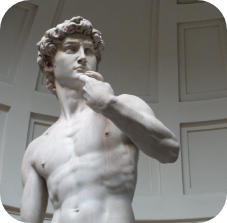
David by Michelangelo
Michelangelo di Lodovico Buonarroti Simoni was a key artist of the Italian High Renaissance. He was only 26 years old when he was commissioned to carve the sculpture, David, as part of a series that would line the roof of the Saint Mary of the Flower Cathedral. However, once the 6-ton piece was completed, it was impossible to lift it. Thus, the sculpture was placed in the Palazzo della Signoria instead.See more >

Venus de Milo
Coming soon...
Portrait of Zofia Potocka by Walery Gadomski
Coming soon...
Charging Bull by Arturo Di Modica
Coming soon...Featured

Cultural Heritage
Cultural Heritage is an expression of the ways of living developed by a community and passed on from generation to generation, including customs, practices, places, objects, artistic expressions and values. The concept of the cultural heritage is often based on historically changing value systems, where the values are recognised by different groups of people.
History
The word History comes from the Greek word, 'Historia', meaning 'inquiry; knowledge acquired by investigation. Today, History is simply defined as the study of the past. Historians seek to understand and represent the past through narratives, and they often debate which narrative best explains a past, as well as its significance.
21st Century's Cities
In the early 21st century, cities around the world have grown as never before. Today, cities are engines of production and trade, forges of scientific and technological innovation, and crucibles of social change. Urbanisation is a major driver of change in contemporary societies. While the processes involve acute social inequalities and serious environmental problems, urbanisation also offers opportunities with on-going discourses for us to move towards a future of greater prosperity, environmental sustainability, and social justice.Cultural Heritage

Machu Picchu, Peru
In the Quechua Indian language, “Machu Picchu” means “Old Peak” or “Old Mountain.” This heritage site is an Incan citadel set high in the Andes Mountains in Peru. A symbol of the Incan Empire and built around 1450AD.See more >

Uluru/Ayers Rock, Australia
Uluru, or Ayers Rock, is a massive sandstone monolith in the heart of the Northern Territory’s arid Red Centre in Australia. Uluru is sacred to indigenous Australians and is thought to have started forming around 550 million years ago. It is within Uluru-Kata Tjuta National Park, which also includes the 36 red-rock domes of the Kata Tjuta (colloquially The Olgas) formation.See more >

Jabal al-Lawz, Saudi Arabia
Most people think that Saudi Arabia is just a vast extent of sand dunes but with its summit at 2 549 meters above sea level Jabal al-Lawz is the highest mountain of Tabuk Province. The mountain is located in northwest Saudi Arabia, near the Jordanian border, above the Gulf of Aqaba.See more >

Stonehenge, England
Stonehenge is perhaps the world’s most famous prehistoric monument located on the Salisbury Plain in Wiltshire, England. It consists of an outer ring of vertical Sarsen standing stones, each around 13 feet high, 7 feet wide, and weighing around 25 tons, topped by connecting horizontal lintel stones. This monument is an extraordinary source for the study of prehistory, it holds a pivotal place in the development of archaeology.See more >

Château De Bonaguil, France
Château de Bonaguil is a castle in the French commune of Saint-Front-sur-Lémance, but actually owned by the neighbouring commune of Fumel in the Lot-et-Garonne département. The castle was the last fortified castles built in France during the Middle Ages. When it was constructed, it was considered a marvel of military architecture that incorporated the latest development in defensive protection against artillery. Today, it stands as one of the most impressive and evocative castle ruins in France.See more >

Poseidon Temple, Greece
Coming soon...
Heddal stave church, Norway
Coming soon...
Shuri Castle, Japan
Coming soon...History

Trench, WWI
Trench warfare is a type of land warfare using occupied fighting lines largely comprising military trenches. It is a long, deep ditches dug as protective defences. During World War I, the western front in France was fought using trench warfare. By the end of 1914, both sides had built a series of trenches that went from the North Sea and through Belgium and France. As a result, neither side gained much ground for three and a half years from October 1914 to March of 1918.See more >

Renault FT Tank (FT-17), WWI
The Renault FT (frequently referred to in post-World War I literature as the FT-17, FT17, or similar) was a French light tank that was among the most revolutionary and influential tank designs in history. The FT was the first production tank to have its armament within a fully rotating turret.See more >

Air–Sea Rescue craft, ASR-10, WWII
This Air-Sea Rescue craft, known as ASR-10, is a rare example of a type once stationed in the North Sea and English Channel. It is highly-visible and it had no engines. Its role during World War II was to provide emergency shelter for the crews of downed aircraft, and it contained vital equipment and supplies. Stranded men were able to radio for assistance ensuring that a fast rescue vessel would be sent out.See more >

Little Boy, WWII
Little Boy was the code name for one of the two American atomic bombs that ended World War II in August 6, 1945, and the devastation will be forever remembered. Tens of thousands of residents of Hiroshima, Japan were killed by “Little Boy". It was the first nuclear weapon used in warfare.See more >

Bristol F.2 Fighter, WWI
The Bristol Fighter was designed in 1916 as a replacement for the B.E. two-seaters. It proved an excellent fighting machine when flown in the aggressive manner of a single-seater. By the end of the war, Bristol F.2 Fighters had been used for offensive patrols, photographic reconnaissance, escort fighting and ground attacks.See more >

Samidare Destroyer, WWII
Coming soon...
The Triumph of the Republic, France
Coming soon...21st Century's Cities

Amsterdam
While cycling is key to Amsterdam’s character, the city is best known for its artistic heritage, elaborate canal system and narrow houses with gabled facades, and its legacies of the city’s 17th-century Golden Age. Its Museum District houses the Van Gogh Museum, works by Rembrandt and Vermeer at the Rijksmuseum, and modern art at the Stedelijk.See more >

London
London is a 21st-century city with history stretching back to Roman times. At its centre stand the imposing Houses of Parliament, the iconic Big Ben clock tower and Westminster Abbey, which is the site of British monarch coronations. Across the Thames River, the London Eye observation wheel provides panoramic views of the South Bank cultural complex, and the entire city.See more >

Madrid
Madrid is a city of elegant boulevards and expansive, manicured parks such as the Buen Retiro. It’s known for its rich repositories of European art, including the Prado Museum’s works by Goya, Velázquez and other Spanish masters. The heart of old Hapsburg Madrid is the portico-lined Plaza Mayor, and nearby is the baroque Royal Palace and Armory, displaying historic weaponry.See more >

Paris
Paris is a major European city and a global center for art, fashion, gastronomy and culture. Its 19th-century cityscape is crisscrossed by wide boulevards and the River Seine. Beyond such landmarks as the Eiffel Tower and the 12th-century, Gothic Notre-Dame cathedral, the city is known for its cafe culture and designer boutiques along the Rue du Faubourg Saint-Honoré.See more >

Berlin
The Bristol Fighter was designed in 1916 as a replacement for the B.E. two-seaters. It proved an excellent fighting machine when flown in the aggressive manner of a single-seater. By the end of the war, Bristol F.2 Fighters had been used for offensive patrols, photographic reconnaissance, escort fighting and ground attacks.Berlin is the capital and chief urban centre of Germany. The city lies at the heart of the North German Plain, athwart an east-west commercial and geographic axis that helped make it the capital of the kingdom of Prussia and then, from 1871, of a unified Germany. Berlin’s former glory ended in 1945, but the city survived the destruction of World War II. It was rebuilt and came to show amazing economic and cultural growth. The city is also known for its art scene and modern landmarks like the gold-coloured, swoop-roofed Berliner Philharmonie, built in 1963.See more >

Kuala Lumpur
Kuala Lumpur is the capital of Malaysia. Its modern skyline is dominated by the 451m-tall (1,483 ft) Petronas Twin Towers, a pair of glass-and-steel-clad skyscrapers with Islamic motifs. The towers, which is the ninth world's tallest building, also offer a public skybridge and observation deck. The city is also home to British colonial-era landmarks such as the Kuala Lumpur Railway Station and the Sultan Abdul Samad Building.See more >
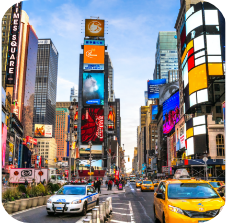
New York City
New York City comprises 5 boroughs sitting where the Hudson River meets the Atlantic Ocean. At its core is Manhattan, a densely populated borough that’s among the world’s major commercial, financial and cultural centers. Its iconic sites include skyscrapers such as the Empire State Building and sprawling Central Park. Broadway theater is staged in neon-lit Times Square.See more >

Cairo
Cairo is the third largest, and second-most populous city in Africa. Set on the Nile River, the heart of the city is Tahrir Square and the vast Egyptian Museum, a trove of antiquities including royal mummies and gilded King Tutankhamun artifacts. Nearby, Giza is the site of the iconic pyramids and Great Sphinx, dating to the 26th century BC. In Gezira Island’s leafy Zamalek district, 187m Cairo Tower affords panoramic city views.See more >
Featured

Assyria and Ancient Mesopotamia
Assyriology is the archaeological, historical, and linguistic study of Assyria and the rest of ancient Mesopotamia and of the related cultures that used cuneiform writing.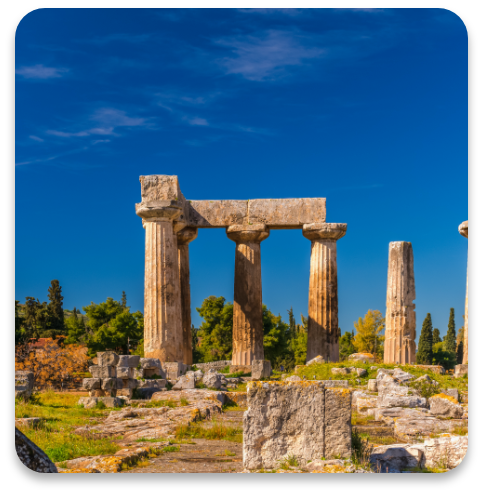
Greece & Rome
Classical Archaeology is the study of Mediterranean (mainly ancient Greek and Roman) society on the basis of surviving material remains.
Egypt
Egyptology is the study of ancient Egyptian history, language, literature, religion, architecture and art from the 5th millennium BC until the end of its native religious practices in the 4th century AD. In archaeology, Egyptology is considered as a branch.
India
In general, Indology (or Indian studies) is the academic study of the history and cultures, languages, and literature of India and as such is a subset of Asian studies. In archaeology, Indology is a subfield of study.
China
Sinology or Chinese studies focuses on the study of China primarily through Chinese philosophy, language, literature, culture and history. Sinology is a subfield of study in Archaeology.Assyria and Ancient Mesopotamia (Assyriology)

Eagle-headed figure, Palace of Ashurnasirpal II
Ashurnasirpal II was the king of Assyria from 883 to 859 BC. His palace was built and completed in 879 BC in Kalhu, which is in modern-day Iraq slightly north of Baghdad. This relief of an eagle-headed demon is one of the many reliefs bore elaborate carvings, in which many are portraying the king surrounded by winged protective spirits, or engaged in hunting or on campaign.See more >

King Tiglath-Pileser III
Tiglath-Pileser III was a prominent king of Assyria in the 8th century BCE who introduced advanced civil, military, and political systems into the Neo-Assyrian Empire. He made sweeping changes to the Assyrian government, considerably improving its efficiency and security. He also subjected Syria and Palestine to his rule, and later (729 or 728) he merged the kingdoms of Assyria and Babylonia.See more >

Wall panel relief 645 BC - 635 BC
Coming soon...
Site 2 Qasr Shemamok
Coming soon...Greece & Rome (Classical Archaeology)
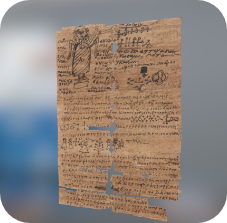
Byzantine-Medieval Papyrus
The Byzantine Empire, also referred to as the Eastern Roman Empire, was the continuation of the Roman Empire in its eastern provinces during Late Antiquity and the Middle Ages. Paper made from papyrus was the chief writing material in ancient Egypt, it was later adopted by the Greeks, and eventually used extensively in the Roman Empire. The 3D model is an artefact from the Byzantine-Medieval period. It contains illustrations and magical texts of a love charm.See more >

Trajan's Column: Palmyrene Soldiers
Trajan was a Roman emperor who ruled from A.D. 98 until his death in A.D. 117. Born in Italica (Seville in modern-day Spain), Trajan was the first Roman emperor born outside of Italy. He was also one of the first emperors to be chosen, rather than to inherit power as part of a ruling family. The second of the Five Good Emperors, Trajan served as an instrumental figure in the Roman Empire’s expansion during the second century A.D.See more >

Ludovisi Battle sarcophagus
Coming soon..
Furriers' guild chest in Myślenice
Coming soon..Egypt (Egyptology)

Eye of Ra
Ra is the ancient Egyptian deity of the sun, and the Eye of Ra is an extension of Ra's power that functions as a feminine counterpart to the sun god Ra and a violent force that subdues his enemies. Despite the relationship, the Eye of Ra behaves as an independent entity, which can be personified by a wide variety of Egyptian goddesses, including Hathor, Sekhmet, Bastet, Wadjet, and Mut. The Eye goddess also acts as mother, sibling, consort, and daughter of the sun god. She is his partner in the creative cycle in which he begets the renewed form of himself that is born at dawn.See more >

Coffin from El Hiba
El Hiba is the modern name of the ancient Egyptian city of Tayu-djayet, an ancient nickname meaning - their walls in reference to the massive enclosure walls built on the site. The ancient Egyptians believed in afterlife, and in order for the soul of the dead to have an afterlife the body needed to be preserved on earth. Part of the afterlife preparations was to purchase a sarcophagus, a coffin and possibly an inner coffin. Coffins were generally made of wood, metal, stone or pottery. Gold and silver was used on some coffins, but this was generally reserved for kings or royalty.See more >

Statue of Ramesses III
Coming soon...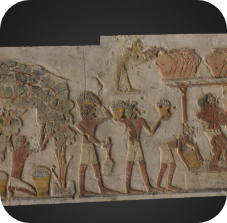
Wine-making Scene (Tomb of Paheri)
Coming soon...India (Indology)

Dancing Ganesha
Ganesha, also known as Ganapati and Vinayaka, is one of the most worshipped deities in the Hindu pantheon. Ganesha has many attributes, but he is readily identified by his elephant head. He is revered as the remover of obstacles; the patron of the arts and sciences; the deity of intellect and wisdom, and is often invoked as patron of letters and learning during writing sessions.See more >

Fence-rail from Bharhut
The 3D model is an early 2nd century BCE carving from a stupa at the site of Bharhut in northwest India. It provides an early document of Buddhist faith and art in India. Buddhism is an ancient Indian religion, which arose in and around the ancient Kingdom of Magadha (now in Bihar, India), and is based on the teachings of the Gautama Buddha who was deemed the Awakened One. Buddhism spread outside of Magadha starting in the Buddha's lifetime.See more >

Marriage of Shiva and Parvati, 19th century
Coming soon...
Shiva as Nataraia
Coming soon...China (Sinology)

Mythological creature
Chinese mythology has been passed down in oral form or recorded in literature in China. Chinese mythology includes many varied myths from regional and cultural traditions. Much of the mythology involves exciting stories full of fantastic people and beings, the use of magical powers, often taking place in a mythological place or time. Like many mythologies, Chinese mythology has in the past been believed to be, at least in part, a factual recording of history.See more >

Amoghasiddhi Buddha
Amoghasiddhi is one the Five Cosmic Buddhas of the Mahayana tradition. It is believed that after the historic Buddha attained enlightenment and ascended to the heavens, he preached to the gods, some of whom became enlightened beings, or buddhas, themselves. These five preside over the four cardinal directions (north, south, east, and west) and also the center. A devotee’s goal is to be reborn into one of their realms.See more >

Gui (food vessel)
Coming soon...





